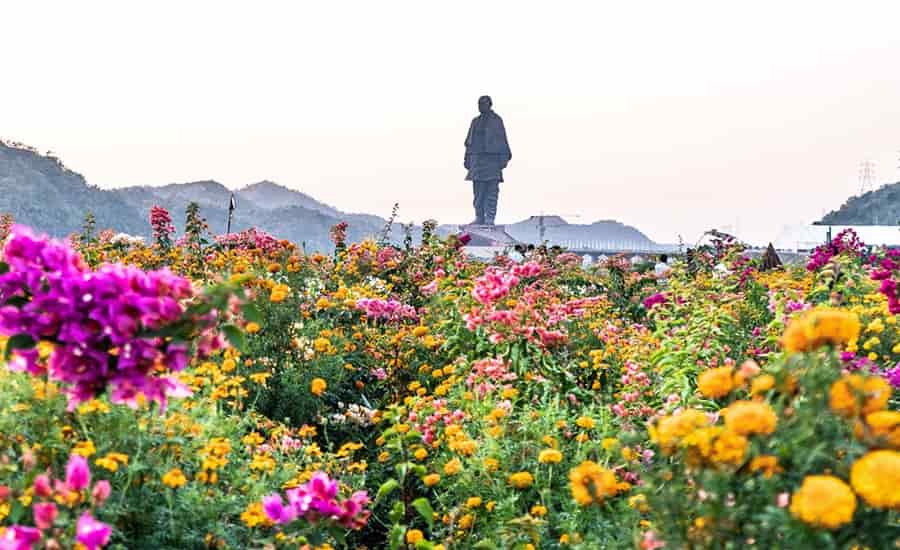The Statue of Unity, a colossal tribute to Sardar Vallabhbhai Patel, stands proudly as the world’s tallest statue, drawing visitors from across the globe. Situated in the Indian state of Gujarat, this iconic monument warrants careful consideration when planning a visit. To make the most of your experience, it is crucial to choose the right time that aligns with favorable weather conditions, ensuring a comfortable and enjoyable trip. In this guide, we will delve into the details of the best time to visit the Statue of Unity, taking into account the seasons, weather patterns, and temperatures.

Seasons
Gujarat experiences three distinct seasons: summer, monsoon, and winter. Each season has its unique charm, but the ideal time to visit the Statue of Unity largely depends on individual preferences and tolerance for specific weather conditions.
Summer (March to June)
Weather Overview
- Summer in Gujarat is characterized by high temperatures, often soaring above 40°C (104°F).
- The region is dry, with minimal rainfall during this season.
Advantages of Visiting in Summer
- Clear skies and sunny weather provide excellent visibility for admiring the statue and its surroundings.
- Fewer crowds compared to other seasons, allowing for a more intimate experience.
Challenges
- Intense heat can be challenging for outdoor activities, necessitating precautions such as hydration and sun protection.
- Afternoon temperatures can be particularly harsh, making it advisable to plan visits during the cooler mornings or evenings.
Monsoon (July to September)
Weather Overview
- Monsoon brings relief from the scorching summer heat, with temperatures ranging from 25°C to 35°C (77°F to 95°F).
- The region receives moderate to heavy rainfall during this season.
Advantages of Visiting in Monsoon
- Lush green landscapes and refreshed surroundings enhance the scenic beauty of the statue.
- Cooler temperatures make outdoor exploration more comfortable.
Challenges
- Heavy rainfall may lead to occasional flooding and travel disruptions.
- Slippery surfaces and wet conditions can impact the ease of movement around the statue complex.
Winter (October to February)
Weather Overview
- Winter is the most pleasant season, characterized by mild temperatures ranging from 10°C to 25°C (50°F to 77°F).
- The air is crisp and dry, with little to no rainfall.
Advantages of Visiting in Winter
- Comfortable weather allows for extended outdoor activities and exploration.
- Ideal for those who prefer mild temperatures and clear skies.
Challenges
- Winter is the peak tourist season, leading to larger crowds and potentially longer waiting times.
Weather Conditions
Understanding the specific weather conditions during your visit is crucial for planning activities and ensuring a memorable experience.
Summer Weather Conditions
- Hot and dry weather with temperatures often exceeding 40°C (104°F).
- Clear skies provide excellent visibility for panoramic views.
Monsoon Weather Conditions:
- Moderate to heavy rainfall, enhancing the greenery around the statue.
- Cooler temperatures compared to summer, ranging from 25°C to 35°C (77°F to 95°F).
Winter Weather Conditions
- Mild temperatures ranging from 10°C to 25°C (50°F to 77°F).
- Dry and clear skies, offering pleasant conditions for outdoor activities.
Temperature Considerations
The temperature plays a vital role in determining the overall comfort and enjoyment of your visit. Understanding the temperature variations across seasons is essential for planning appropriate attire and activities.
Summer Temperatures
- Daytime temperatures often exceed 40°C (104°F).
- Nighttime temperatures may drop to around 25°C (77°F).
Monsoon Temperatures
- Daytime temperatures range from 25°C to 35°C (77°F to 95°F).
- Nights are relatively cooler, with temperatures around 20°C (68°F).
Winter Temperatures
Daytime temperatures range from 10°C to 25°C (50°F to 77°F).
Nights can be chilly, with temperatures dropping to around 5°C (41°F).
Best Time to Visit
Considering the various factors discussed, the ideal time to visit the Statue of Unity can be narrowed down based on individual preferences:
For Those Who Prefer Mild Weather
- Winter (October to February) is the most suitable time, offering pleasant temperatures and clear skies.
For Nature Enthusiasts
- Monsoon (July to September) provides lush greenery and a refreshing ambiance, although precautions are necessary due to rainfall.
For Those Tolerant of High Temperatures
- Summer (March to June) allows for fewer crowds and clear visibility, but visitors should be prepared for intense heat.
Tips for a Comfortable Visit
Regardless of the chosen season, here are some general tips to ensure a comfortable and enjoyable visit to the Statue of Unity:
Stay Hydrated
- Carry an adequate supply of water, especially during the summer months.
Sun Protection
- Use sunscreen, wear a hat, and carry sunglasses to protect yourself from the intense summer sun.
Comfortable Attire
- Dress in light, breathable clothing during summer, and carry a light jacket or sweater for winter visits.
Check Weather Forecasts
- Stay updated on weather forecasts, especially during the monsoon season, to plan your visit accordingly.
Plan Ahead
- Consider booking tickets in advance and planning your itinerary to make the most of your time at the statue complex.
Conclusion
Choosing the best time to visit the Statue of Unity involves a careful consideration of individual preferences, tolerance for different weather conditions, and the desired experience. Whether you prefer the mild temperatures of winter, the lush greenery of the monsoon, or the solitude of summer, proper planning and preparation will enhance your visit to this iconic monument, ensuring a memorable and fulfilling experience.
Also Read:
Popular Tour Packages
